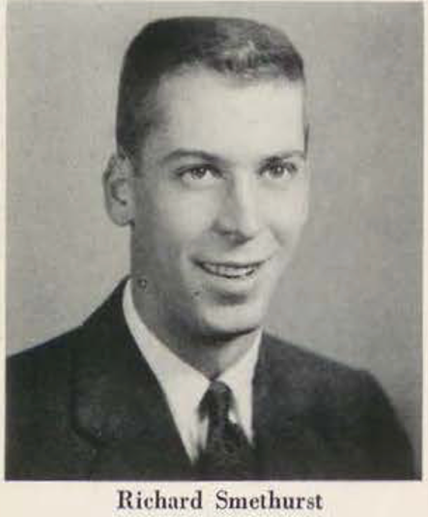
Richard Jacob (“Dick”) Smethurst, a noted scholar of modern Japanese history at the University of Pittsburgh, passed away on May 4, 2024, at the age of 90 in the Westminster Place Senior Living facility in Oakmont, PA.
Dick was born in 1933 in Carlisle, PA, the youngest son of Edward William (“Bill”), Sr. and Helen (nee Wiener) Smethurst. He was a devoted husband, gifted scholar, fantastic teacher, avid marathon runner, Army veteran and a wonderfully charming, warm hearted, gregarious gentleman.

Dick’s childhood years were happily spent with his parents and older brother Bill, Jr. in Carlisle, Bloomfield, NJ and Montclair, NJ, where he graduated from Montclair High School in 1951. He attended Dickinson College in Carlisle, PA, where he met his future wife Mae Elizabeth Johnson in the Classical Documents room at the library during his junior year. He majored in history and graduated cum laude in 1955, winning the Morris Prinz prize for outstanding history major, while Mae was a student of classical Greece and Rome. After graduation, Dick went into the Army as an intelligence officer. Dick and Mae married in December 1956, between semesters of Mae’s senior year, while Dick was on leave from the Army. After studying Japanese at the Army Language School in Presidio, California, Dick was sent to a post in Japan. Mae followed him to Japan soon after he arrived. While there, Mae taught Latin and French at the American School, and they both developed a life-long connection to Japan and its people. In particular, both were passionate about the theater, seeing productions of Kabuki and Noh, as well as Japanese art, all of which would play roles in both of their scholarship. While in Japan, Dick became friends with J. Thomas Rimer, who later would become a noted scholar of Japanese literature and a colleague at the University of Pittsburgh.
Following his tour of duty in the Army in 1959, both Mae and Dick Smethurst went to the University of Michigan for graduate study. Dick received a Master’s in Japanese Studies from the University of Michigan in 1961, where he studied with James B. Crowley, and after further time in Japan for language study and research, they both returned to Michigan, where Dick studied history under Roger F. Hackett. Dick and Mae received their doctorates at the same time in 1968, Dick in History and Mae in Classics. In 1967, both were hired to teach at the University of Pittsburgh, Dick in the History Department and Mae in the Classics Department. Both would teach at Pittsburgh until their retirement in 2013. Dick served as chair of the History Department from 1988 to 1994, and in the 1990s he became a research associate in the Institute for Monetary and Economic Studies of the Bank of Japan and in the Business Faculty of Keio University.
Dick wrote three books:
A Social Basis for Prewar Japanese Militarism: The Army and the Rural Community (University of California Press, 1974), based on his doctoral dissertation, is a study of the Imperial Military Reserve Association and other related organizations, examining the role that they played in rural villages and their promotion of army causes, using Yamanashi Prefecture as a sample case.

His second book was Agricultural Development and Tenancy Disputes in Japan, 1870-1940 (Princeton University Press, 1986). While doing the research for his first book, he spoke to many former tenant farmers whose careers went back to the beginning of the century, and found that their memories of their pre-war experiences did not match the current scholarly orthodoxy, that the government drained the peasants through an exploitative land tax, forcing them more and more deeply into tenancy, debt, and poverty, eventually causing them to fall prey to the military and radical right. Through his conversations and subsequent research, he found, despite occasional setbacks, that there was a general increase in rural prosperity over these years, that the average peasant had “both a better standard of living and a greater sense that he could control his own life than most interpretations of rural society allow.”
Dick received fierce criticism about the book from critics, especially those wedded to a Marxist interpretation of history, resulting in one of the most heated debates in the field in that decade, in the pages of most of the major journals, in both Japanese and English. Dick’s side of the story can best be found in the essay, “A Challenge to Orthodoxy and Its Orthodox Critics: A Reply to Nishida Yoshiaki” (The Journal of Japanese Studies, Vol. 15, No. 2 (Summer, 1989), pp. 417-437.

His final major book was From Foot Soldier to Finance Minister: Takahashi Korekiyo, Japan’s Keynes (Harvard University Asia Center, 2007). While working to reply to his critics of the previous book, Dick embarked on a study of the Japanese economy of the early 1930s. While doing so, he became fascinated with the life of one of the key economic figures of that period, Takahashi Korekiyo, and shifted his focus to a biography of Takahashi. The book is an engaging mixture of intimate biographical detail and insightful analysis of the finances and bureaucracy of Japan during the long period that Takahashi served as a Bank of Japan official, finance minister (seven times), and, briefly, prime minister, and received widespread acclaim.
Besides Dick’s work in the Pittsburgh History Department, he was also a key figure in the creation of the university’s vibrant East Asian Studies program, including an interdisciplinary master’s degree. Dick and the other members of the program, together with an excellent staff at the library, helped to create an East Asian studies collection whose holdings rival that of more prominent institutions.
Mae published frequently on noh and kyōgen, as well as Greek drama. She, Dick, and Tom Rimer regularly hosted Japanese noh and kyōgen troupes, as well as contemporary theater troupes, for performances and workshops at the University of Pittsburgh. They also actively collected Japanese art prints, prints that became the basis of a major 2007 exhibit that Dick and Mae co-curated at the Frick Art Museum in Pittsburgh. Together, they amassed one of the largest private collections of Noh block prints in the world, particularly those by Tsukioka Kōgyo, much of which has been donated to the University of Pittsburgh, and were published in the digital archive Tsukioka Kōgyo, The Art of Noh, 1869-1927.

Dick was working on Japanese military history and the causes of World War II in his final years. Some of his findings were published in the article “Planning for War: Elite Staff Officers in the Imperial Japanese Army and the Road to World War II” (The Asia-Pacific Journal, November 2020).
Mae passed away on December 15, 2019 at home, just short of their 63rd anniversary. Dick continued to live in their home until earlier December 2023, when he moved into a rehabilitation ward.
A memorial service for Dick Smthurst will be held at 11:30am, June 17 at the Church of the Redeemer in the Squirrel Hill neighborhood of Pittsburgh (5700 Forbes Ave).
— Submitted by Andrew Hall, Kyushu University

